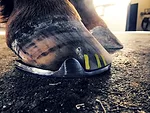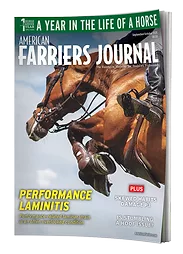Advertise Follow Us
American Farriers Journal

View Archived Issues
May/June 2015
Volume: 41
Edition: 4
American Farriers Journal is the “hands-on” magazine for professional farriers, equine veterinarians and horse care product and service buyers.
-
Table Of Contents
Table Of Contents
Shoeing For A LivingOrganization, tough choices and hard work help Missouri farrier to excelRead MoreBack Up the Horse’s Entire Foot, Not Just the Toe
Dressing the heels appropriately makes it easier to control the toeRead MoreThoughts On Medial-Lateral Balance
Colorado farrier Jim Quick shares food for thought on trimming and shoeing for a balanced footRead MoreThe Farrier’s Role in Keratoma Cases
Connecticut farrier shares successful protocol to remove tough tumorsRead MoreRemembering Hank McEwan
The legacy of this horseshoer will live on through the work of the many farriers he taught and inspiredRead MoreIs There a Link Between Limb Length Disparity and Asymmetrical Feet?
A study measured the hooves of a small group of horses used in a previous study that examined limb length disparityRead MoreAttacking Canker with Frequent Debridement and Addressing Environment
California farrier’s case points to importance of every-other-day hoof-knife work and controlling housing factorsRead MoreIn The ShopVultures, Horseshoes and Everything In-Between
A visit to Indiana farrier Tom Willoughby’s shop gives insight to how practicing ornamental blacksmithing can translate to forging skills with horseshoesRead MoreBe Part Of The Farriers Spotlight
We’re looking for more pictures and stories of our favorite hard workers for the 17th annual National Farriers WeekRead MoreRemembering Joe Kutz
A farrier until the end, the International Horseshoeing Hall of Fame member will be remembered by many for his dedication to his peers and the industryRead MoreSheared Heels and the Correlation to a Quarter Crack
A quarter crack repair will be of little value unless the cause of the defect is not identified and rectifiedRead MoreGiving Your Opinion for a Pre-Purchase Exam
It is important to reserve your opinions on a horse specifically related to its footcareRead MoreWhere Does the Problem Originate?
An extreme case of scoliosis and other issues provide a reminder to look beyond the feet and that conformation can limit what farriers can do to help a horseRead MoreTool Tips From A Tool Master
Wisconsin farrier Roy Bloom shares several quick tips for getting the most from the tools you use everydayRead MoreCaudal Heel Pain & Navicular Syndrome
Thinking more broadly about caudal heel pain, rather than focusing solely on the navicular bone, can help the hoof-care team develop an appropriate treatmentRead More3 Things To Remember About Gas Forges
Keeping a forge running its best isn’t hard, but can be easily ignoredRead MoreTraining Horses to be Farrier-Friendly
Tips and tools you can recommend to get your clients’ horses to stand betterRead MoreSpotlight On Hoof CareHorse Owner Education Clinic Helps Solidify Client/Farrier Relationships
The Midwest Horseshoeing School’s horse owner clinic helped educate horse owners and bridge the gap between farrier knowledge and understanding their clientsRead More -
Featured Articles
Featured Articles
Shoeing For A LivingFinding Success In Simplicity
Organization, tough choices and hard work help Missouri farrier to excelRead MoreBack Up the Horse’s Entire Foot, Not Just the Toe
Dressing the heels appropriately makes it easier to control the toeRead MoreIs There a Link Between Limb Length Disparity and Asymmetrical Feet?
A study measured the hooves of a small group of horses used in a previous study that examined limb length disparityRead More - Digital Edition
-
Online Extras
Online Extras













